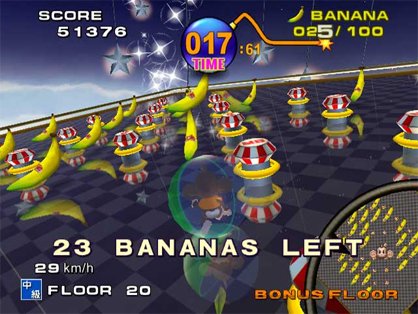Can indirect control ever be better than left/right/jump?
Yuji Naka's new platformer isn't the traditional kind
The reason for this is clearly to take advantage of the opportunities offered by the Wii-mote and DS-style touch screen control systems as you place and manipulate vines to move your Kiwi bird through the level. And possibly to avoid direct comparisons with Sonic.
But is this kind of control system actually appealing? As someone whose mind baulked the first time Link auto-jumped off a ledgein Zelda, I have to say the thought of all thispalaver just to move is a bit disappointing. How do you feel about it?
Take a look at the game in motion:
First impressions? The art style is good and the level design looks inventive and seems to flow well. Also, not enough games have Kiwi birds as the central character (The New Zealand Story is the only other one that springs to mind). But now look at an expert player having a go:
At this speed, the indirect control system detaches you from the character to the point that it becomes a faceless object. You may as well be pulling a ball through the maze with the ivy - that's the way your brain will come to see it because your attention is no longer on the character.
Asyou can see from the end of the level, the littlekiwi dude(ette, I believe) has much potential forlikeability. But that’s the telling thing – it’s only when the game isn’t in progress that you get any kind of impression of the character’s personality.
A sense of detachment isn'tthe only problem with indirect control schemes. Despite Capcom's Zack & Wiki having loads of plus points, there's no denying there were several occasions when the pointer control for character movement was infuriating - especially when you've got a Nunchuk with a perfectly good analogue stick in your hand. For all the game's intelligent and innovative Wii-mote control, basic character movement suffered from compulsory use of the pointer.
Sign up to the GamesRadar+ Newsletter
Weekly digests, tales from the communities you love, and more

Above: The Wii-mote shines in Zack & Wiki - but basic movement doesn't
So has any game really succeeded with indirect control? Some lead characters are completely controlled by external influences, such as Echochrome, which sees little men walking forward inexorably until they meet an obstacle. You influence their movement through manipulating the environment, never by saying 'turn around' by pushing the opposite directional button.
Essentially, this is the same as classic puzzler Lemmings. The little fellas keep walking and it’s up to you to save them. While you do influence them more directly than Echochrome (by giving individuals umbrellas, instructions or by blowing them up), you're still trying to control the uncontrollable.
One indirectly-controlled platformer that centres around a single character in a more traditional-looking game is Yoshi’s Touch & Go on DS. This started off life as a tech demo for the DS’s touch screen, but was so addictive, it was released as a full game.
The result was awesome. The depth of scoring and control offered by the touch-screen interface is superb (except when you play outside and the mic mistakes the breeze for your breath, leaving baby Mario to plummet through cloud vapour).
But, great though it is, even this idea doesn't seem enough to fill a whole game. It's comprised oftwo sections - falling through the air, then travelling right on Yoshi's back... then it ends. It works because you learn the route through the sky and how to collect everything through repetition. As a whole, it's a memorable experience, but it's still a rather restricted video game.
Then there's NiGHTS: Journey of Dreams on Wii. Not only was the 'mindsight'systemone of the most broken control methods ever seen, even the developers played the gamewith a Gamecube controllerthrough personal choice.

Above: 'Mindsight' Wii-mote control was abysmal in new NiGHTS
Are any indirectly-controlled games truly magnificent? Killer 7 is unquestionably a classic and featured a somewhat detached control scheme...andtellingly it's a niche title despite its brilliance. Heavy Rain is anothergame that plays with control conventions to the point of alienation - andit certainly isn't for everyone. It's hard to think of one game with both critical acclaim and mass-appeal that's truly satisfied as much as traditional button-controlled titles.
Even Super Monkey Ball, which is a logical fit for the Wii-mote and iPhone is still most playable on a Gamecube with an analogue stick. Even though you're indirectly controlling AiAi via the tilting ground, you're essentially pushing the direction you want to go, which is about as direct as you can get without controlling the monkey's feet.

Above: Super Monkey Ball: The best indirect control system ever?
I don't think any of the above is a fear of change on my part or a reaction to motion control in general. Even when you only have buttons to play the game, I'd much rather have direct control of my character. Put it this way - do you think Yuji Naka would have had such a massive hit on his hands in 1991 if Sonic had any control system that wasn't left/right and jump?
04 May, 2010
Justin was a GamesRadar staffer for 10 years but is now a freelancer, musician and videographer. He's big on retro, Sega and racing games (especially retro Sega racing games) and currently also writes for Play Magazine, Traxion.gg, PC Gamer and TopTenReviews, as well as running his own YouTube channel. Having learned to love all platforms equally after Sega left the hardware industry (sniff), his favourite games include Christmas NiGHTS into Dreams, Zelda BotW, Sea of Thieves, Sega Rally Championship and Treasure Island Dizzy.



